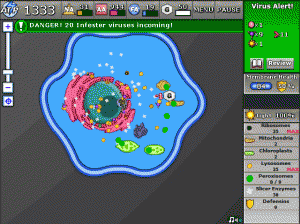Played Cellcraft this morning, which turned out to be one of the best science education games I’ve seen in a while.
First off, here’s a screenshot of my cell being attacked by viruses (click to zoom). Note the various organelles, as well as the use of ATP, nucleic acids, amino acids, fatty acids, and glucose as game resources.
Cute, huh? Here’s what I like about it:
- Most obviously, it’s fun, and even addictive. This should really be a minimum expectation for educational games, but evidence suggests it’s not.
- It treats the science being taught as a functioning, interactive system, then leverages that interactivity to build game mechanics. Instead of just using the science as a backdrop (like, say, SpaceChem, which uses chemical elements as the context for a mechanical puzzle solving game), all of the game decisions you make in Cellcraft are directly tied into the science. It maps the necessary elements of cell biology directly onto gameplay in a way that’s simple and elegant. Likewise, it doesn’t trivialize gameplay by making the game all about learning – you’re not forced to work through obviously educational activities – the learning’s there, but it’s part of the game.
- It employs narrative to make the whole experience more compelling and engaging. Granted, the story is simple (involving an alien race of platypuses attempting to create a colony of amoeba seeded with platypus DNA to be shipped across space to reconstruct their species elsewhere), but it’s humorous and compelling – the characters have all of 3-4 minutes screen time in total (appearing as narrators during play and as actors in short animated cut-scenes), but they’re quirky and odd enough to grab your attention in a way that most educational games fail to.
- It puts the scientific details in the foreground. All of the modeled cell machinery is exposed, so that, for example, when you choose to have your cell produce lysosomes, you see RNA extruding from the nucleus, being converted into proteins in the rough endoplasmic reticulum, in turn triggering the creation of vesicles from the smooth endoplasmic reticulum, which are finally converted to lysosomes at the Golgi apparatus. The point being that you’re constantly seeing the details happen; they’re not hidden away, but likewise, they don’t interfere with play – they’re like the replacement of progress bars in certain kingdom simulations with the animation of a building being constructed – informative, interesting, but not intrusive.
- It follows the lessons of tutorial-style play. It’s often said that game tutorials epitomize ideal learning in that they’re narratively led, interactive, direct, and encouraging in the face of failure. While many game tutorials are just awful, some successfully implement mastery learning by constantly challenging the player with small increases in difficulty and knowledge, followed by opportunities to demonstrate their mastery of that knowledge. Every game level teaches something new about cell biology, and each level is divided into smaller chunks that present clear, achievable, if challenging, goals, while avoid the feel of play becoming formulaic. Really, my biggest complaint about the game is that it ran out of new biology to teach me, and so ran out of levels for me to play.
- It provides access to deeper knowledge throughout. Obvious, the cells in Cellcraft are a toy system – they’re simplified from the real biology, creating an accessible model with sufficient complexity to make play interesting, but not so much that it becomes taxing. Despite this, however, it laces in references and access to the corresponding scientific ideas, much in the same way that Civilization used to in its Civilopedia. Extra knowledge is there, tantalizingly, but it’s not required – it’s an optional extra whose presence suggests that it might offer useful further insight to the advanced player.
- It’s explicit about its compromises. Obviously, the simplifications necessary for elegant game play will cause the game to diverge somewhat from the science behind it. Instead of just ignoring this problem, Cellcraft clearly states when it’s deviating in this way, partly by including relevant notes in the narrative (such one character’s shock at the idea of implanting chloroplasts in an animal cell), and partly by offering comparisons between game elements and the real science in its in-game help.
- Finally, it’s a class act. It has a simple yet humorous and strong aesthetic style, an elegant interface, good sound and music, and is well written. I only encountered one minor bug, in which the simulation of the cell’s outer membrane (based on moving splines of some sort) became unstable and spun out of control, shunting the cell’s nucleus into the surrounding fluid. Though this didn’t kill it directly, all of my cell defenses were trapped in the cytoplasm, and so it was quickly co-opted by viruses, quickly overwhelming it.
All in all, a very strong game – if you’re not familiar with basic cell biology, play it; you’ll learn a lot. You can download it to play on your own machine, or you can play it online. For more information, check out the designer’s blog for some interesting discussion including a entertaining piece about how they’re NOT creationists, even though they’ve got platypus “designers” creating cells..
![[ meme – hazard ]](http://www.meme-hazard.org/blog/wp-content/uploads/2016/11/mh_banner.png)
